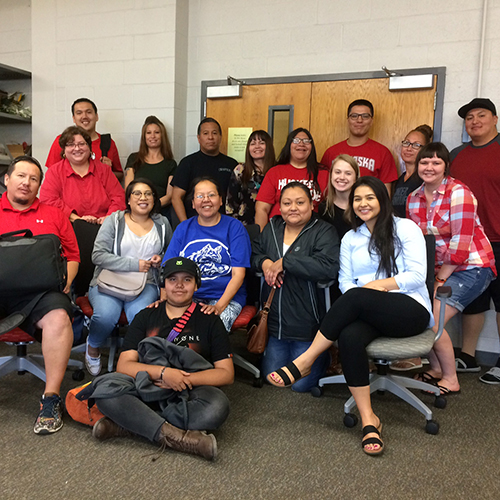Changing lives in Native American communities
Indigenous people are described as having unique histories and cultures and are usually tied to specific territories. With a great respect for Native American culture in Nebraska and a goal of helping Native students earn teaching degrees, the Department of Teaching, Learning and Teacher Education developed the Indigenous Roots (ROOTS) program.
Currently funded by a $1.2 million professional development grant from the U.S. Department of Education’s Office of Indian Education, ROOTS will serve up to 24 students over the next four years. Students will have the opportunity to earn their undergraduate degree in teacher education or post-graduate certificates in ELL and special education. The grant pays tuition and a monthly stipend for students registered in full-time coursework. The stipend also supports students enrolled in semester-long practica and student teaching.

ROOTS students receive most of their instruction in a hybrid format that includes live video instruction, web-based learning, and face-to-face interactions that bring instructors and ROOTS classmates together throughout the year—an essential component to student success. Over a 17-year history, 45 teachers have graduated from the program and currently serve K-12 students across Nebraska and the Midwest.
“People need to know how great the program is,” says Nepthys Justo, member of the Santee Dakota Tribe of Nebraska, who prior to becoming a teacher was working at “exhausting” jobs in beef and chicken processing factories. “Not just because, hey, you get a free education, but because it changes your life. My life has completely changed because of my degree. I am able to provide a good life for my children. I work hard during the school year, but I get the flexibility to be home with them in the summer and to be able to do things with them that I never would have been able to, if I’d been working at a beef packing plant.”
Justo earned her bachelor’s degree in elementary education in 2007, and ROOTS partially funded her master’s degree, completed in 2013. She now teaches third grade at Niobrara Public Schools, where approximately 75 percent of the students are Native American.
“The primary goal of our program is for our graduates to teach in Native schools or to work in settings supporting K-12 Native students,” said Nancy Engen-Wedin, who has coordinated ROOTS for nearly two decades. “This is win-win-win. You get teachers for school districts that need them and teachers who are deeply committed to the success of their students.”
Supporting Native American languages, culture, history and traditions is another important aspect of ROOTS. In addition to teaching traditional subjects, ROOTS teachers work with their students to develop and integrate Native culture and language(s) into math, science, social studies, the arts and other subjects. Students also learn concepts for effectively teaching English language learners and apply these practices to helping K-12 students learn their local Native languages: Ho-Chunk (Winnebago), Umonhon (Macy) and Dakota (Santee).
Engen-Wedin says ROOTS graduates are in demand by school districts who serve Native communities. Superintendents contact her to follow up on the status of the students in the program. One of those in-demand students was Sarah Widger, a member of the Umonhon Tribe of Nebraska, who is now serving as the Native American education liaison for Lincoln Public Schools and is excited to give back, after receiving so much help from ROOTS.

“This program taught me how to navigate the education process, and now after graduating, I’m able to do that for my Native youth and Native families,” said Widger. “Transitioning through elementary, middle and high school are really huge steps that happen quite rapidly for the families I work with. Our number one goal is to develop academic success and to raise graduation rates.”
“I feel that most of the students, once graduated, have become leaders in their community and are the ones then to carry it on,” said Engen-Wedin.
And that multiplier effect is what has made the Indigenous Roots program so valuable to Native American children and families, schools, communities and Nebraska.
Project ID 43139: Indigenous Roots Teachers Education Program

